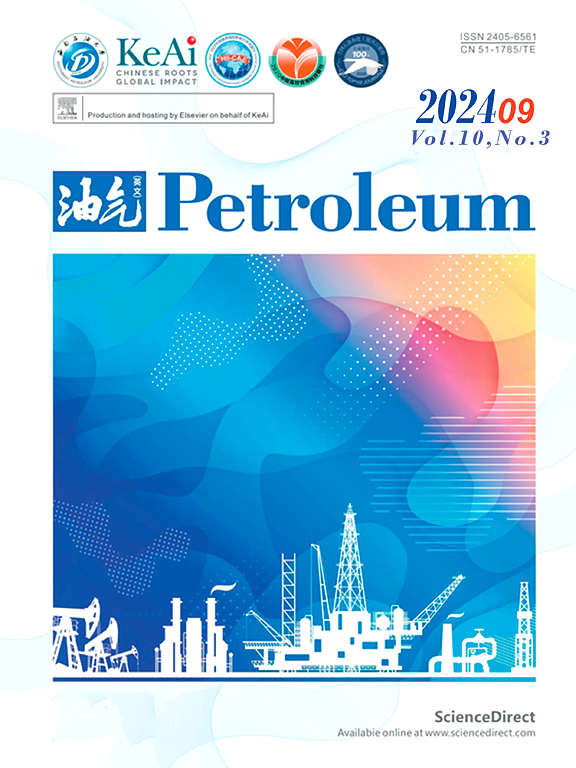水力压裂用新型耐高温疏水缔合聚合物的合成与表征
IF 3.5
Q2 ENERGY & FUELS
引用次数: 0
摘要
水力压裂是油气开采的关键工艺,特别是在高温深层和超深层油藏中,部分水解聚丙烯酰胺(HPAM)等传统聚合物由于耐热性差而失效。本研究介绍了一种新的疏水缔合水溶性聚合物(HAWSP), AASN,旨在克服HPAM的局限性。AASN是由一种特殊设计的双尾疏水单体(C8NC12AM)与丙烯酰胺、丙烯酸和2-丙烯酰胺-2-甲基丙磺酸(AMPS)共聚而成,该聚合物具有优异的粘度和热稳定性。其独特的结构基于双尾单体之间的疏水相互作用,在溶液中形成坚固的粘弹性网络。该网络在压裂作业中非常有效地输送支撑剂,无需额外的交联剂,简化了现场应用,减少了残留对地层的潜在损害。流变试验表明,AASN在高达140°C的温度下保持高粘度和强抗剪切性。研究还考察了其在不同过硫酸铵浓度下的破胶性能,表明其易降解,压裂后对环境影响小。AASN的开发显著改善了压裂液的性能,标志着油田聚合物技术的重要进步。它为目前的解决方案提供了一种有前途的耐热替代方案,有可能改变高温水力压裂的做法。本文章由计算机程序翻译,如有差异,请以英文原文为准。
Synthesis and characterization of a novel high temperature resistant hydrophobic associative polymer for hydraulic fracturing
Hydraulic fracturing is a critical process in oil and gas extraction, particularly in high-temperature deep and ultra-deep reservoirs where traditional polymers like partially hydrolyzed polyacrylamide (HPAM) fail due to poor heat resistance. This study introduces a novel hydrophobic associative water-soluble polymer (HAWSP), AASN, designed to overcome HPAM’s limitations. AASN is synthesized by copolymerizing a specially designed two-tailed hydrophobic monomer (C8NC12AM) with acrylamide, acrylic acid, and 2-acrylamido-2-methylpropanesulfonic acid (AMPS), producing a polymer with excellent viscosity and thermal stability. Its unique structure, based on hydrophobic interactions among two-tailed monomers, forms a robust viscoelastic network in solution. This network is highly effective in transporting proppant during fracturing operations without the need for additional cross-linking agents, simplifying field application and reducing potential formation damage due to residue. Rheological tests show AASN maintains high viscosity and strong shear resistance at temperatures up to 140 °C. The study also examines its gel-breaking performance with different concentrations of ammonium persulfate, demonstrating easy degradation and low environmental impact after fracturing. The development of AASN significantly improves the performance of fracturing fluids and marks an important advancement in oilfield polymer technology. It offers a promising, heat-resistant alternative to current solutions, potentially transforming high-temperature hydraulic fracturing practices.
求助全文
通过发布文献求助,成功后即可免费获取论文全文。
去求助
来源期刊

Petroleum
Earth and Planetary Sciences-Geology
CiteScore
9.20
自引率
0.00%
发文量
76
审稿时长
124 days
期刊介绍:
Examples of appropriate topical areas that will be considered include the following: 1.comprehensive research on oil and gas reservoir (reservoir geology): -geological basis of oil and gas reservoirs -reservoir geochemistry -reservoir formation mechanism -reservoir identification methods and techniques 2.kinetics of oil and gas basins and analyses of potential oil and gas resources: -fine description factors of hydrocarbon accumulation -mechanism analysis on recovery and dynamic accumulation process -relationship between accumulation factors and the accumulation process -analysis of oil and gas potential resource 3.theories and methods for complex reservoir geophysical prospecting: -geophysical basis of deep geologic structures and background of hydrocarbon occurrence -geophysical prediction of deep and complex reservoirs -physical test analyses and numerical simulations of reservoir rocks -anisotropic medium seismic imaging theory and new technology for multiwave seismic exploration -o theories and methods for reservoir fluid geophysical identification and prediction 4.theories, methods, technology, and design for complex reservoir development: -reservoir percolation theory and application technology -field development theories and methods -theory and technology for enhancing recovery efficiency 5.working liquid for oil and gas wells and reservoir protection technology: -working chemicals and mechanics for oil and gas wells -reservoir protection technology 6.new techniques and technologies for oil and gas drilling and production: -under-balanced drilling/gas drilling -special-track well drilling -cementing and completion of oil and gas wells -engineering safety applications for oil and gas wells -new technology of fracture acidizing
 求助内容:
求助内容: 应助结果提醒方式:
应助结果提醒方式:


